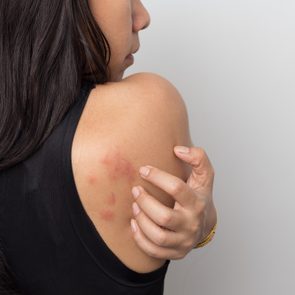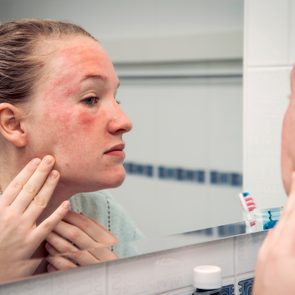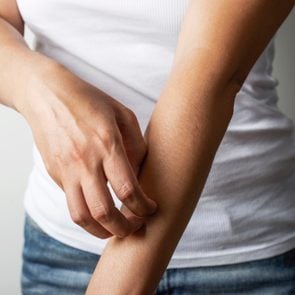Do You Get Hives in the Cold? 7 Things to Know About Cold Urticaria
Updated: Jul. 06, 2021
Some people get hives in cold water or weather, known as cold urticaria. Here are pictures of cold urticaria, as well as how to treat and prevent them.
Cold urticaria: when cold temperatures causes hives
You know that an allergic reaction can lead to hives. But you could’ve sworn the cold triggered your outbreak. But that isn’t possible … or is it?
It’s not just your imagination. You may be dealing with a very real condition known as cold urticaria, a hive reaction caused by exposure to cold temperatures.
It can be triggered by cold wind, weather, or swimming in cold water, or even too much air conditioning, drinking a cold beverage, or holding a cold object.
“Cold urticaria is a skin condition when the skin reacts to colder temperatures by becoming red and itchy,” says Howard Sobel, MD, a clinical attending dermatologic surgeon at Lenox Hill Hospital.
While hives are incredibly common, cold urticaria is fairly rare, according to the National Organization for Rare Disorders.
Here’s everything you need to know about cold urticaria: what it is, how to treat it, and how to prevent it from flaring up.
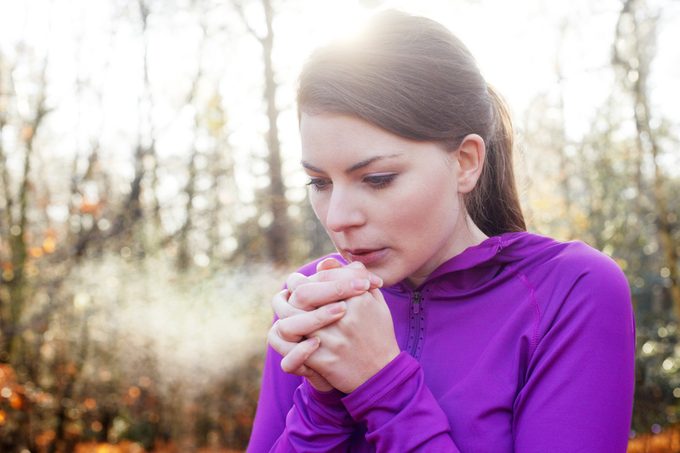
Is cold urticaria genetic?
It’s unlikely your genes are to blame for your cold urticaria—it’s not believed to be an inherited condition.
There is, however, a genetic form of the disease, known as familial cold autoinflammatory syndrome (FCAS).
“Familial cold autoinflammatory syndrome is genetic, caused by a mutation in the cold-induced autoinflammatory syndrome gene [NLRP-3],” says Sunitha Posina, MD, a board-certified internist in New York City.
It’s usually seen in infancy and early childhood, she says.
“FCAS is a rare inherited disorder characterized by episodes of rash, fever, joint pain, and signs or symptoms of systemic illness, unlike cold urticaria,” Dr. Posina explains.
Who gets cold urticaria?
If you have the more common form of cold-induced hives, they may be a result of an underlying condition.
“You are slightly more likely to develop cold urticaria if you have an underlying condition that compromises your immune system,” says Dr. Sobel, founder of the skin care line Sobel Skin Rx. “Some with the condition have sensitive skin cells due to some sort of virus or an illness.”
The condition has been linked to infectious diseases and hematologic conditions, says Sunitha Posina, MD, a board-certified internist in New York City.
Among them: cryoglobulinemia (a condition where blood proteins clump together at lower temperatures), chronic lymphocytic leukemia (CLL), chicken pox, syphilis, viral hepatitis, and infectious mononucleosis, says Dr. Posina.
Cold urticaria affects men and women in equal numbers, but it’s most common in younger adults—something that mystifies experts, says Dr. Sobel.
But just because you’re older doesn’t mean you’re out of the woods.
“Most cases are usually seen in the young and middle-aged adults, but can also be seen in children and the elderly too,” says Dr. Posina.
(This is how your body deals with freezing weather.)
Is cold urticaria an allergy?
In short: yes.
Dr. Sobel says that cold-induced hives are a hypersensitivity reaction, which sets off a histamine release. As a result, the skin develops hives.
“It can be considered an allergy and categorized as a reactive skin disorder because the body is having an abnormal response to the temperature and environment it is in,” he says.
If you wonder if you might be one of the people who experience cold urticaria, you don’t have to wait long to find out. Hives will develop very quickly after exposure to the cold, popping up in under a minute.
The FCAS reaction is slightly different.
“Wheals develop during the cold exposure, or more commonly while warming up again, in cold urticaria, whereas more symptoms appear in FCAS,” says Dr. Posina.
(Stress is another surprising cause of hives: here’s why it happens.)
Where do cold urticaria appear?
If you’ve managed to cover up your entire body, you’re in luck, right? No hives!
Not so fast.
“Hives can either be localized, occur only in the area exposed to cold, or generalized, distributed over [the] body in response to cold exposure,” says Jennifer Segal, MD, a board-certified dermatologist and founder of Metropolitan Dermatology Institute in Houston.
In other words, only uncovered areas (like your hands or your face) might break out in cold urticaria. Or merely being cold could cause hives to occur somewhere on your body, even if that area is covered. The latter reaction is rarer, however.
In general, says Dr. Sobel, chances are the hives will be confined to the exposed areas.
In some cases people can experience anaphylaxis, a rare but potentially life-threatening allergic reaction that causes a drop in blood pressure and other symptoms.
Treatment with an EpiPen, which is an auto-injector preloaded with the drug epinephrine, can counter this severe allergic reaction and save a person’s life.
(This is why you get hives on your face.)
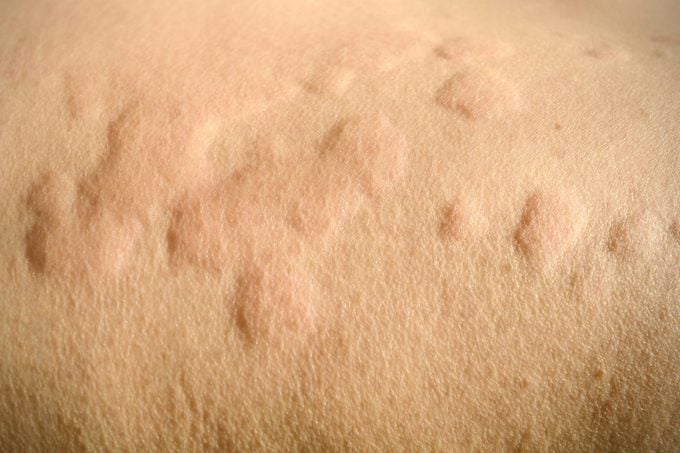
How can you tell if you have cold urticaria?
Curious how to tell cold urticaria hives apart from other hives or rashes? It may be tricky.
“Aside from distribution—when hives can occur in a limited area that has been exposed to cold—hives in the setting of cold urticaria look exactly the same as hives that result from other triggers,” says Dr. Segal.
In general, the cold urticaria itch, swell, and may have a white ring around them, like all hives, says Dr. Sobel.
To test whether you have cold urticaria, try the ice cube trick: put an ice cube on your skin to see if there’s a reaction to freezing temperatures.
“Where the ice is placed on the skin is where the reaction will happen, not necessarily all over the body,” he says.
Another trick: paying attention to when the welts appear. “If it happens immediately after cold exposure/stimulus, then most likely it is cold urticaria,” says Dr. Posina.
(Here’s everything you need to know about dermatographic urticaria.)
How long do cold urticaria hives last?
If you’re dealing with cold urticaria after exposure to extreme cold, you likely don’t have to wait long for your skin to calm down.
“The cold urticaria reaction usually arises within five to 10 minutes of cold exposure and lasts about one to two hours,” says Dr. Posina.
If the hives are taking a bit longer to go away, that’s still normal. Hives tend to resolve within 24 hours, says Dr. Segal.
Dr. Sobel says some hives may reoccur for weeks, months, or even longer. In that case, you may be venturing into the realm of chronic hives and should see a doctor to determine if there’s an underlying issue, such as an autoimmune disorder or some other skin condition.
Ultimately, it’s common for cold urticaria to be a long road. “Generally, the disorder will last for a few years, and up to even 10 years in a few patients,” says Dr. Posina.
How do you treat and prevent cold urticaria?
Because cold urticaria is an allergic reaction, it’s important to monitor your symptoms to make sure you don’t need to see a doctor immediately.
Treatment
“Given the range of severity and sometimes unpredictable nature of allergic reactions, it is safest for the treatment of any allergic or inflammatory condition to be under the care of an experienced physician,” says Dr. Segal.
Treatment for hives usually includes an antihistamine such as Benadryl or other helpful medication.
“If your skin is having a reaction after being exposed to the cold, then you should see a doctor to determine if it is serious or not,” says Dr. Sobel. If it is necessary, they can prescribe an antihistamine.
“There are rare cases where it can be dangerous because the patient can lose consciousness in extreme cold temperatures if their case is serious,” he says.
Prevention
The best way to prevent future outbreaks of cold-related hives is to keep away from extreme temperatures as much as you’re able. Ultimately, if you experience cold-triggered hives, it may require a complete lifestyle overhaul.
“Prevention is by lifestyle modification to avoid flares, such as protecting oneself well from severe cold exposure if possible and avoiding exposure to [an] acute drop in temperatures,” says Dr. Posina.
You’ll probably want to wear warm clothing during cold weather and avoid any cold water in a bath, shower, or swimming pool, says Dr. Sobel.
If you’re dealing with frequent cold urticaria, see a physician for possible desensitization to cold treatment. If you have a history of anaphylactic reactions in general, Dr. Posina strongly recommends carrying epinephrine (aka an EpiPen). Taking antihistamines can also be helpful.
Next, check out what happens to your body in extreme temperatures.




















